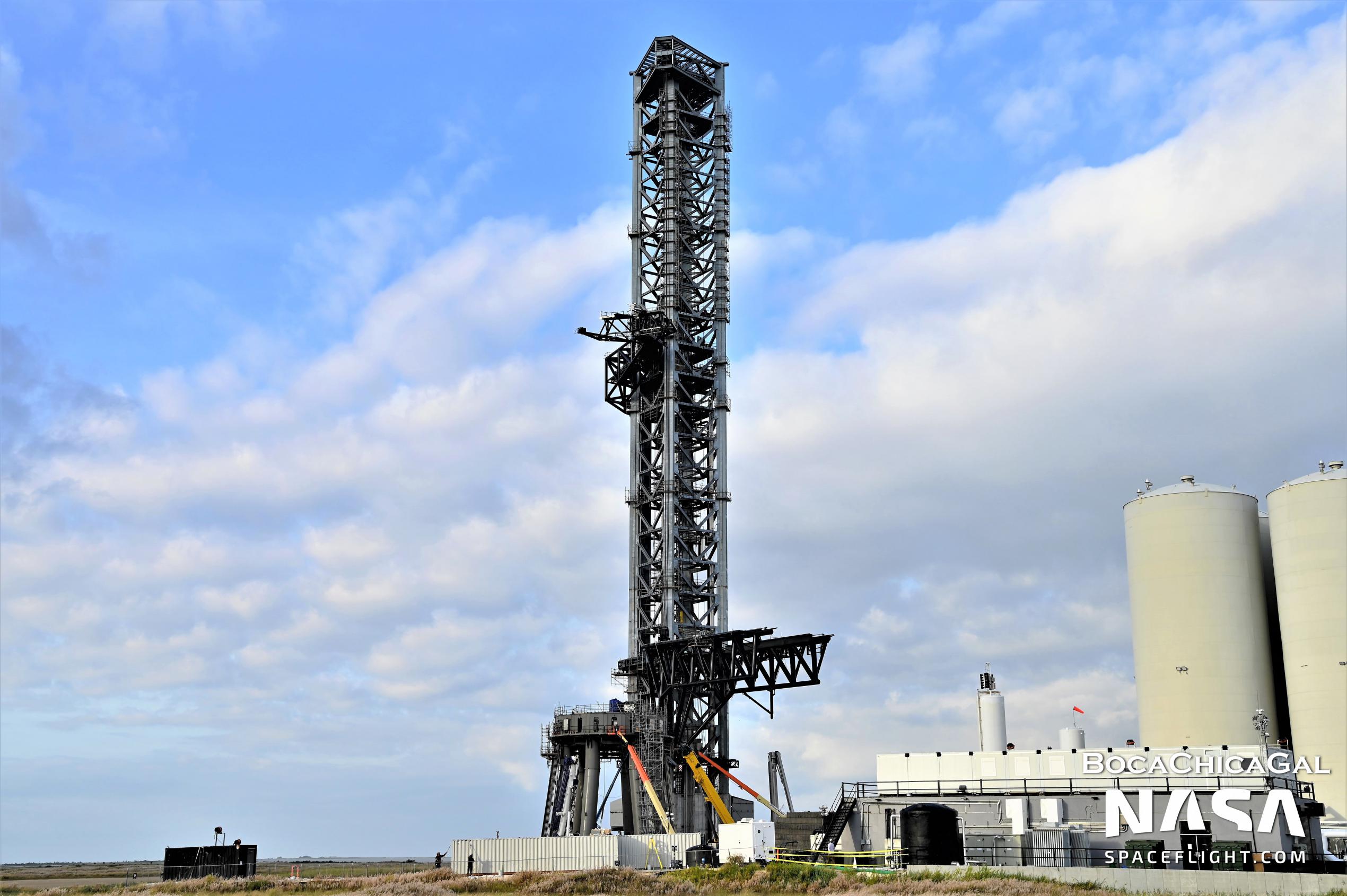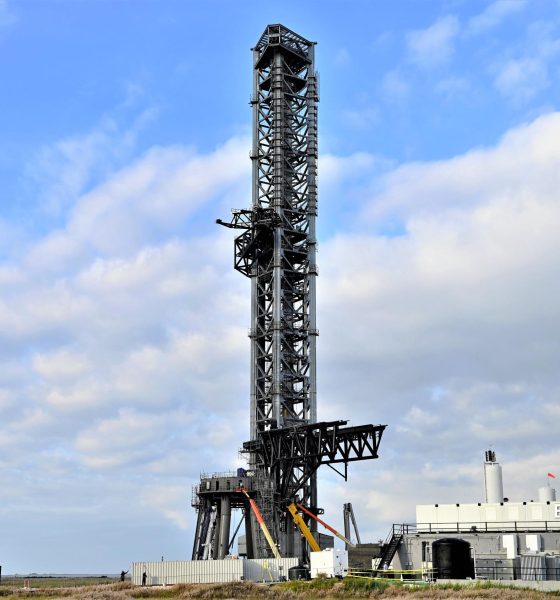

News
SpaceX preparing to assemble launch tower for Starship’s first Florida pad
SpaceX has slowly but surely begun the process of building Starship’s first Florida launch pad – including preparations for the off-site assembly of a second skyscraper-sized ‘launch tower.’
This is not the first time. Back in late 2019, SpaceX began work on a Starship launch pad located at NASA’s Kennedy Space Center (KSC) LC-39A pad, which the company already leased for Falcon 9 and Falcon Heavy launches. By the end of the year, some of the framework of the Starship launch mount was already visible and parts of a giant water-cooled thrust diverter arrived in early 2020. However, work on the pad effectively halted around the same time and entered a state of limbo as SpaceX redirected all of its Starship program on South Texas.
Only two years later did activity finally return. Musk revealed the restart on December 3rd, 2021 and within a matter of weeks, the remnants of the old Starship launch pad – now outdated – had been scrapped and removed, returning the site to a more or less blank slate. Since then, save for occasional long-distance aerial views, it’s been almost impossible to document progress but views from SpaceX webcasts of Falcon 9 launches out of Pad 39A have shown that the company is mostly focused on preparing foundations. However, in early February 2022, a flyover of a different SpaceX KSC facility revealed the first clear signs of preparation for pad hardware assembly.
While unassuming, the small sets of square foundations recently constructed at SpaceX’s new Roberts Road Falcon storage, refurbishment, and processing center are virtually identical to the foundations where contractors assembled the first Starship launch tower in South Texas. Each completed section – measuring about 12m (40 ft) long and wide and 18m (60 ft) tall – was then transported a few miles by road to the launch site, where a crane would stack them.
Roberts Road happens to be located about seven miles (11 km) away from Pad 39A, with a single paved, well-maintained road optimized for wide and tall loads standing between them. It’s clear, in other words, that SpaceX will build Pad 39A’s Starship launch tower at its Roberts Road facility and transport the sections to the pad for assembly. More likely than not, to avoid the regular disruption of Falcon launches, SpaceX will do the same with virtually all transportable pad hardware, including the tower arms and launch mount.
In fact, SpaceX has only developed about a third of the land it leased at Roberts Road. Just last month, development plans indicating that SpaceX intends to build two immense warehouse-like buildings to fill out the rest of the site were published by a local water agency. Based on their footprints, they would collectively have more covered floor space than the entirety of the South Texas ‘Starbase’ factory where all Starships are currently built. During a February 10th, 2022 update presentation, CEO Elon Musk confirmed that SpaceX will build and launch Starships out of Florida, all but guaranteeing that the new facility will be a massive new Starship factory.
In the last week, satellite imagery indicates that SpaceX has begun to level the unfinished portion of Roberts Road, likely paving the way for the start of foundation work in the near future. All things considered, it remains to be seen if SpaceX will truly replicate Starbase, Boca Chica at Kennedy Space Center or – much like how the company systematically upgrades its rockets – if the new Starship factory will represent a block upgrade with a wide range of improvements and refinements. Regardless, it won’t be long before Starbase East and the first of several East Coast Starship launch towers begin to take shape.

News
Tesla Model Y Standard Long Range RWD launches in Europe
The update was announced by Tesla Europe & Middle East in a post on its official social media account on X.

Tesla has expanded the Model Y lineup in Europe with the introduction of the Standard Long Range RWD variant, which offers an impressive 657 km of WLTP range.
The update was announced by Tesla Europe & Middle East in a post on its official social media account on X.
Model Y Standard Long Range RWD Details
Tesla Europe & Middle East highlighted some of the Model Y Standard Long Range RWD’s most notable specs, from its 657 km of WLTP range to its 2,118 liters of cargo volume. More importantly, Tesla also noted that the newly released variant only consumes 12.7 kWh per 100 km, making it the most efficient Model Y to date.
The Model Y Standard provides a lower entry point for consumers who wish to enter the Tesla ecosystem at the lowest possible price. While the Model 3 Standard is still more affordable, some consumers might prefer the Model Y Standard due to its larger size and crossover form factor. The fact that the Model Y Standard is equipped with Tesla’s AI4 computer also makes it ready for FSD’s eventual rollout to the region.
Top Gear’s Model Y Standard review
Top Gear‘s recent review of the Tesla Model Y Standard highlighted some of the vehicle’s most notable features, such as its impressive real-world range, stellar infotainment system, and spacious interior. As per the publication, the Model Y Standard still retains a lot of what makes Tesla’s vehicles well-rounded, even if it’s been equipped with a simplified interior.
Top Gear compared the Model Y Standard to its rivals in the same segment. “The introduction of the Standard trim brings the Model Y in line with the entry price of most of its closest competition. In fact, it’s actually cheaper than a Peugeot e-3008 and costs £5k less than an entry-level Audi Q4 e-tron. It also makes the Ford Mustang Mach-E look a little short with its higher entry price and worse range,” the publication wrote.
Elon Musk
Elon Musk’s xAI bets $20B on Mississippi with 2GW AI data center project
The project is expected to create hundreds of permanent jobs, dramatically expand xAI’s computing capacity, and further cement the Mid-South as a growing hub for AI infrastructure.

Elon Musk’s xAI plans to pour more than $20 billion into a massive new data center campus in Southaven, Mississippi, marking the largest single economic development project in the state’s history.
The project is expected to create hundreds of permanent jobs, dramatically expand xAI’s computing capacity, and further cement the Mid-South as a growing hub for AI infrastructure.
xAI goes MACROHARDRR in Mississippi
xAI has acquired and is retrofitting an existing facility in Southaven to serve as a new data center, which will be known as “MACROHARDRR.” The site sits near a recently acquired power plant and close to one of xAI’s existing data centers in Tennessee, creating a regional cluster designed to support large-scale AI training and inference.
Once completed, the Southaven facility is expected to push the company’s total computing capacity to nearly 2 GW, placing it among the most powerful AI compute installations globally. The data center is scheduled to begin operations in February 2026.
Gov. Tate Reeves shared his optimism about the project in a press release. “This record-shattering $20 billion investment is an amazing start to what is sure to be another incredible year for economic development in Mississippi. Today, Elon Musk is bringing xAI to DeSoto County, a project that will transform the region and bring amazing opportunities to its residents for generations. This is the largest economic development project in Mississippi’s history,” he said.
xAI’s broader AI ambitions
To secure the investment, the Mississippi Development Authority approved xAI for its Data Center Incentive program, which provides sales and use tax exemptions on eligible computing hardware and software. The City of Southaven and DeSoto County are also supporting the project through fee-in-lieu agreements aimed at accelerating development timelines and reducing upfront costs.
Founded in 2023 by Elon Musk, xAI develops advanced artificial intelligence systems focused on large-scale reasoning and generative applications. Its flagship product, Grok, is integrated with the social media platform X, alongside a growing suite of APIs for image generation, voice, and autonomous agents, including offerings tailored for government use.
Elon Musk highlighted xAi’s growth and momentum in a comment about the matter. “xAI is scaling at an immeasurable pace — we are building our third massive data center in the greater Memphis area. MACROHARDRR pushes our Colossus training compute to ~2GW – by far the most powerful AI system on Earth. This is insane execution speed by xAI and the state of Mississippi. We are grateful to Governor Reeves for his support of building xAI at warp speed,” Musk said.
Elon Musk
Tesla AI Head says future FSD feature has already partially shipped

Tesla’s Head of AI, Ashok Elluswamy, says that something that was expected with version 14.3 of the company’s Full Self-Driving platform has already partially shipped with the current build of version 14.2.
Tesla and CEO Elon Musk have teased on several occasions that reasoning will be a big piece of future Full Self-Driving builds, helping bring forth the “sentient” narrative that the company has pushed for these more advanced FSD versions.
Back in October on the Q3 Earnings Call, Musk said:
“With reasoning, it’s literally going to think about which parking spot to pick. It’ll drop you off at the entrance of the store, then go find a parking spot. It’s going to spot empty spots much better than a human. It’s going to use reasoning to solve things.”
Musk said in the same month:
“By v14.3, your car will feel like it is sentient.”
Amazingly, Tesla Full Self-Driving v14.2.2.2, which is the most recent iteration released, is very close to this sentient feeling. However, there are more things that need to be improved, and logic appears to be in the future plans to help with decision-making in general, alongside other refinements and features.
On Thursday evening, Elluswamy revealed that some of the reasoning features have already been rolled out, confirming that it has been added to navigation route changes during construction, as well as with parking options.
He added that “more and more reasoning will ship in Q1.”
🚨 Tesla’s Ashok Elluswamy reveals Nav decisions when encountering construction and parking options contain “some elements of reasoning”
More uses of reasoning will be shipped later this quarter, a big tidbit of info as we wait v14.3 https://t.co/jty8llgsKM
— TESLARATI (@Teslarati) January 9, 2026
Interestingly, parking improvements were hinted at being added in the initial rollout of v14.2 several months ago. These had not rolled out to vehicles quite yet, as they were listed under the future improvements portion of the release notes, but it appears things have already started to make their way to cars in a limited fashion.
Tesla Full Self-Driving v14.2 – Full Review, the Good and the Bad
As reasoning is more involved in more of the Full Self-Driving suite, it is likely we will see cars make better decisions in terms of routing and navigation, which is a big complaint of many owners (including me).
Additionally, the operation as a whole should be smoother and more comfortable to owners, which is hard to believe considering how good it is already. Nevertheless, there are absolutely improvements that need to be made before Tesla can introduce completely unsupervised FSD.








